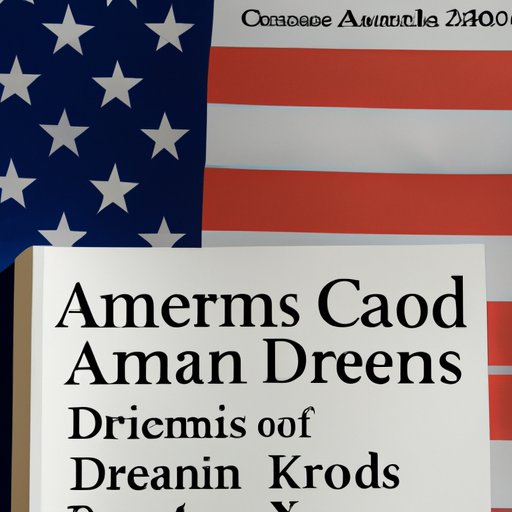Introduction
The American Dream is a concept that has been explored in literature for centuries, from classic works by renowned authors to more contemporary works. It is a term that is used to describe the idea of an individual achieving success through hard work and determination, despite any obstacles they may face. The American Dream has come to symbolize the ideals of freedom, opportunity, and equality for all citizens of the United States. In this article, we will explore how different authors have depicted the American Dream in literature throughout the years.

Analyzing the American Dream through Literary Classics
One of the earliest examples of the American Dream being explored in literature is Herman Melville’s Moby-Dick. In this novel, Captain Ahab is driven by his ambition to capture the white whale, a quest that is ultimately doomed to failure. His story is a cautionary tale about the dangers of pursuing one’s dreams at any cost. Another classic example of the American Dream is F. Scott Fitzgerald’s The Great Gatsby. The protagonist, Jay Gatsby, is a self-made man who is determined to win the love of Daisy Buchanan, a woman from a wealthy family. Although his quest for the American Dream is ultimately unsuccessful, Gatsby’s story serves as a reminder of the power of perseverance and hope.

Exploring the Representation of the American Dream in Contemporary Fiction
The American Dream has continued to be explored in contemporary fiction. One prominent example is Toni Morrison’s Beloved. Set during the Reconstruction Era, the novel follows a former slave named Sethe who is struggling to overcome her traumatic past and find a better life for herself and her daughter. Through Sethe’s story, Morrison illustrates the power of resilience and strength in the face of adversity. Another example is Junot Diaz’s The Brief Wondrous Life of Oscar Wao. The novel follows the titular character, a Dominican-American man living in New Jersey, as he struggles to fulfill his dream of becoming a successful writer. Oscar’s story highlights the challenges faced by immigrants in pursuit of the American Dream.
Themes of the American Dream in Poetry
The American Dream is also explored in poetry. Walt Whitman’s “I Hear America Singing” is a poem that celebrates the spirit of the nation and its people. Through his words, Whitman speaks of a future filled with hope and possibility. Maya Angelou’s “Still I Rise” is another example of a poem that speaks to the power of the American Dream. The poem speaks of the resilience of African Americans and their refusal to be defined by the oppression they face. Both of these poems illustrate the power of the American Dream in inspiring individuals to strive for better lives.

Examining the American Dream in Plays and Screenplays
The American Dream has also been explored in plays and screenplays. Arthur Miller’s Death of a Salesman is a classic example. The play follows the tragic story of Willy Loman, a salesman whose dreams of success are never realized. Through his story, Miller presents a poignant commentary on the pursuit of the American Dream. Another example is Aaron Sorkin’s screenplay for The Social Network. The movie follows the rise of Mark Zuckerberg and the creation of Facebook, illustrating the potential for success that exists in the modern world. Both of these works demonstrate the power of the American Dream in motivating individuals to pursue their goals.
Comparing and Contrasting Different Versions of the American Dream in Literature
Finally, it is important to consider how different versions of the American Dream are presented in literature. For example, Ralph Ellison’s Invisible Man contrasts the idealized version of the American Dream with the harsh reality faced by African Americans. On the other hand, Langston Hughes’s “Let America Be America Again” presents a hopeful vision of the nation and its possibilities. By comparing and contrasting these two works, we can gain a better understanding of how authors have portrayed different versions of the American Dream.
Conclusion
In conclusion, literature has long served as a platform for exploring the American Dream. From classic works to contemporary fiction, poetry, plays, and screenplays, authors have presented a variety of interpretations of the concept. Whether it is used as a source of inspiration or a warning against the dangers of excessive ambition, the American Dream has become an integral part of our cultural identity. As such, it is an essential theme in literature that continues to captivate readers to this day.
(Note: Is this article not meeting your expectations? Do you have knowledge or insights to share? Unlock new opportunities and expand your reach by joining our authors team. Click Registration to join us and share your expertise with our readers.)
